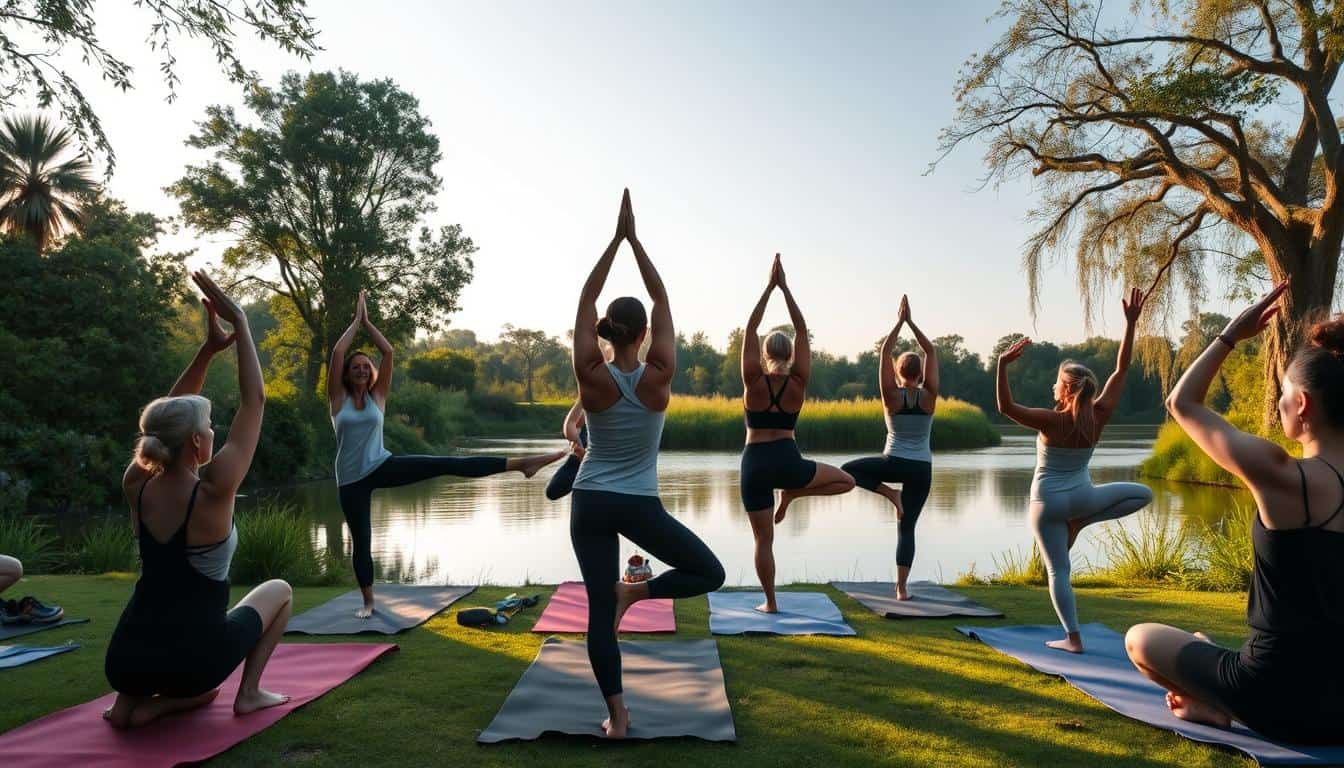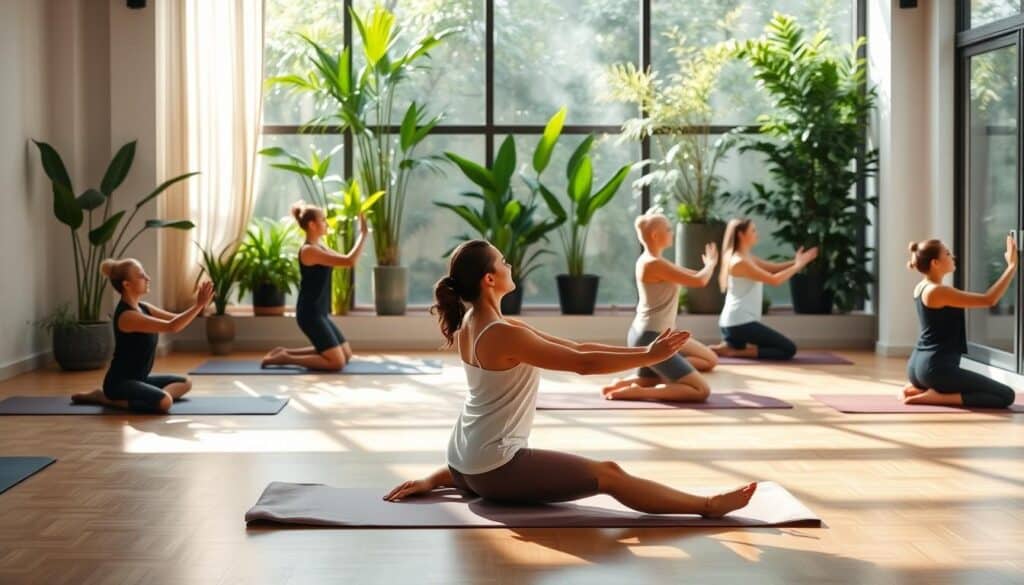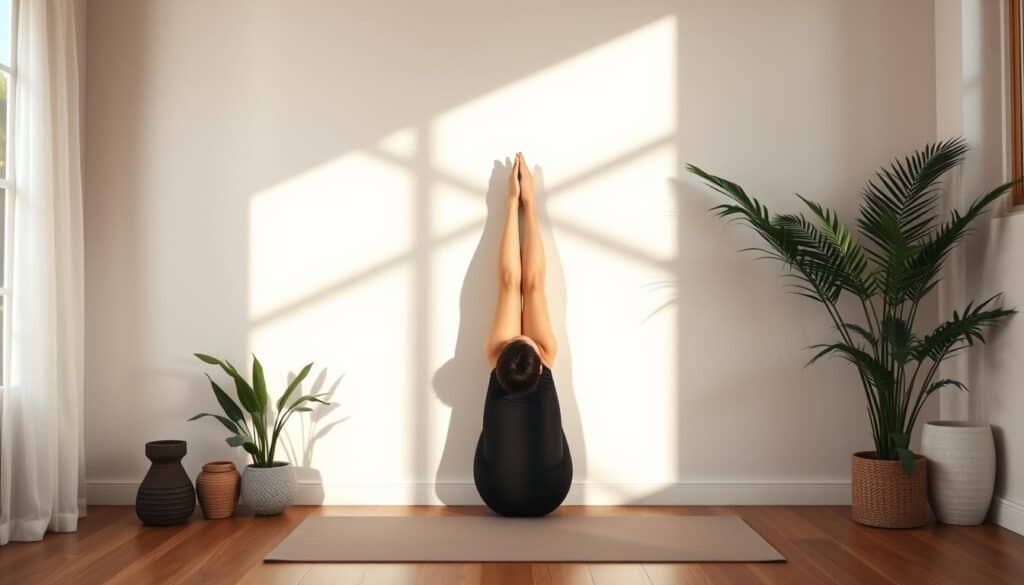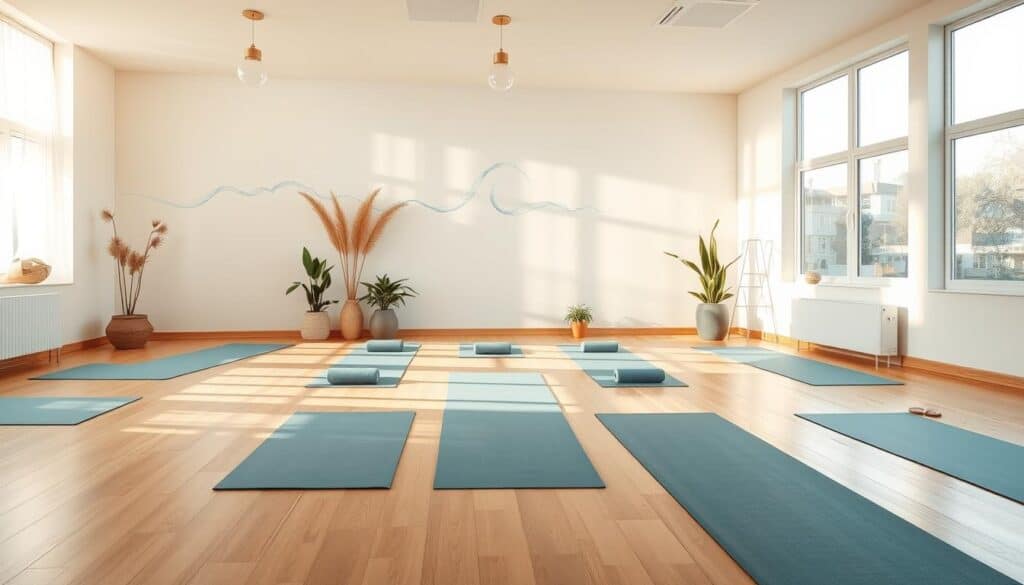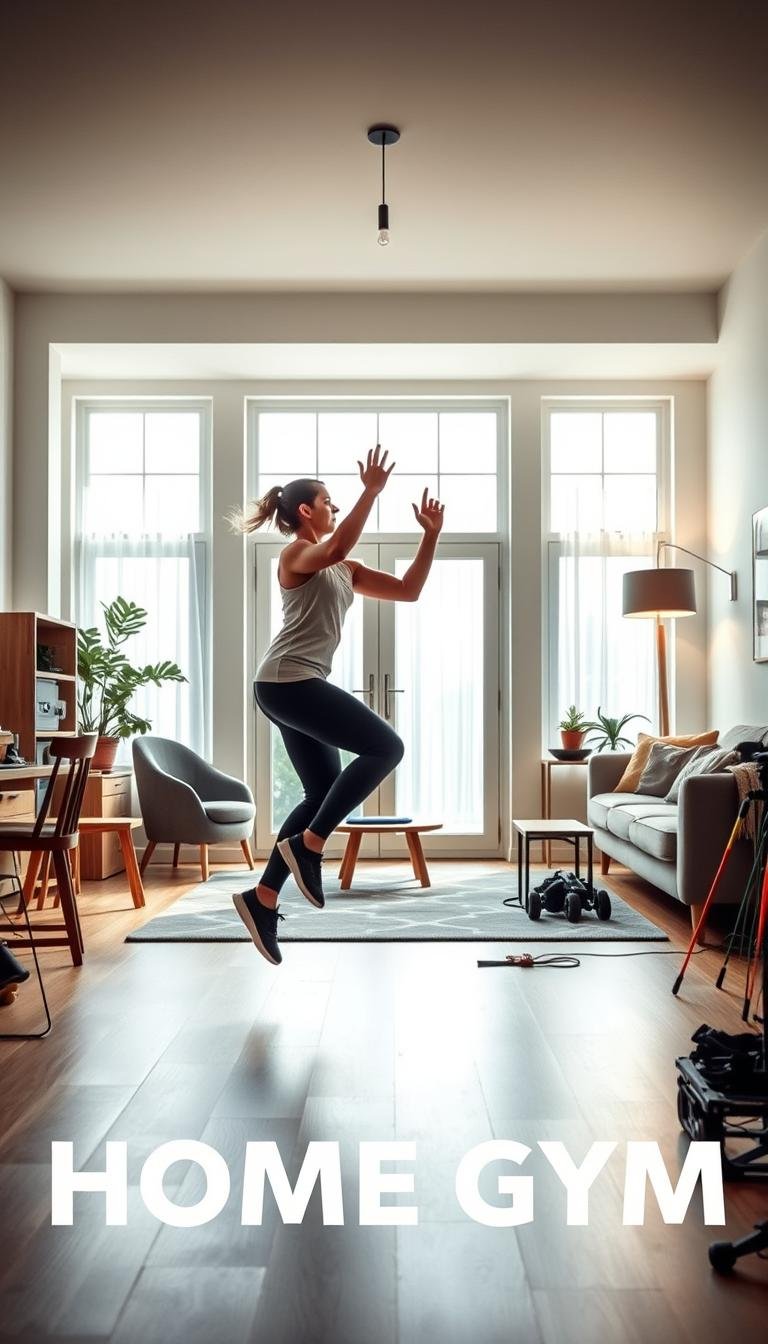(Hey! Some links in this post may be affiliate links — meaning I may earn a small commission if you buy through them, at no extra cost to you. As an Amazon Associate, I earn from qualifying purchases. I only share products I genuinely love and think you’ll find useful too. Read the full disclosure here).
Yoga is an ancient practice that addresses all dimensions of the human system: body, breath, mind, personality, and emotions. It is particularly effective for stress relief, promoting mindfulness and self-compassion through controlled breathing, meditation, mental imagery, and a series of stretching poses or asanas. Even a little yoga can reduce stress, anxiety, and depression. The practice helps balance and tone the connection between body and mind, building the ability to remain calm and relaxed.
Contents
- 1 Understanding Stress and its Impact on the Body
- 2 Benefits of Yoga for Stress Relief
- 3 Key Yoga Poses for Stress Relief
- 4 Incorporating Breathwork in Your Practice
- 5 Creating a Comfortable Yoga Space
- 6 Building a Daily Yoga Routine
- 7 Mindfulness and Meditation in Yoga
- 8 Yoga for Different Stress Levels
- 9 Resources for Further Exploration
- 10 FAQ
- 10.1 What is the connection between yoga and stress relief?
- 10.2 How does yoga help manage the physical and psychological effects of stress?
- 10.3 What are some of the key benefits of yoga for stress relief?
- 10.4 What are some effective yoga poses for stress relief?
- 10.5 How can breathwork enhance the stress-relieving benefits of yoga?
- 10.6 What should I consider when creating a comfortable yoga space for stress relief?
- 10.7 How can I build a daily yoga routine for stress management?
- 10.8 How can mindfulness and meditation enhance the stress-relieving benefits of yoga?
- 10.9 How should my yoga practice for stress relief differ based on the level of stress?
- 10.10 What resources are available for those looking to deepen their yoga practice for stress relief?
Key Takeaways
- Yoga can reduce symptoms of stress, including tense muscles, low energy, headaches, and anxiety.
- Yoga poses can target specific body areas to promote relaxation and stress relief.
- Yoga practice can increase flexibility, strength, balance, and overall well-being.
- Consistent yoga practice is recommended for long-term stress management benefits.
- Incorporating breathwork and mindfulness into yoga practice can enhance its stress-relieving effects.
Understanding Stress and its Impact on the Body
Stress is a natural response that our bodies experience when faced with demanding or challenging situations. However, prolonged and chronic stress can have significant physical and psychological effects. Understanding the impact of stress is crucial for developing effective stress management tools and fostering a healthy mind-body connection.
The Physical Symptoms of Stress
When we experience stress, our bodies respond with a range of physical symptoms, including tense muscles, low energy, dry mouth, headaches, frequent colds, chest pain, shaking, loss of sexual desire, grinding teeth, and upset stomach. These physical manifestations can significantly impact our overall well-being and disrupt our daily lives.
The Psychological Effects of Stress
Stress also takes a toll on our mental and emotional health. Common psychological effects of stress include depression, irritability, mood swings, anxiety, racing thoughts, lack of focus, persistent worrying, forgetfulness, and loneliness. These psychological impacts can further exacerbate the physical symptoms of stress, creating a vicious cycle.
How Yoga Can Help
Fortunately, yoga can be a powerful tool in managing stress. This ancient practice gently eases the mental and physical pace, focusing on mindful breathing, simple meditation, and physical postures. Through this holistic approach, yoga helps reduce stress, lower blood pressure, increase lung capacity, improve respiratory function, and regulate heart rate, ultimately enhancing overall well-being.
Benefits of Yoga for Stress Relief
Yoga has been practiced for over 5,000 years and is considered one of the oldest defined practices of self-development. The benefits of yoga extend far beyond physical fitness, as it also offers remarkable stress relief. By boosting the body’s production of hormones like endorphins, yoga cultivates happiness, health, and feelings of calmness. Endorphins play a crucial role in managing physical pain and negative emotions.
Reducing Cortisol Levels
The practice of yoga helps in reducing cortisol levels, the primary stress hormone. As cortisol levels decrease, the body’s overall stress response is lowered, leading to improved well-being and increased resilience.
Improving Mindfulness
Yoga encourages mindfulness, the ability to stay present and focused in the moment. By directing attention to physical postures, breathing, and mental awareness, yoga helps individuals become more mindful, which in turn reduces stress and anxiety.
Enhancing Mood
Regular yoga practice has been shown to enhance mood and overall well-being. The combination of physical movement, breath work, and meditation helps alleviate symptoms of depression and anxiety, leaving practitioners feeling more relaxed and content.
“Yoga is a holistic stress management technique that reduces the stress response by integrating physical, mental, and spiritual components to improve health, particularly stress-related illnesses.”
Studies indicate that yoga effectively reduces stress levels by lifting mood, increasing mindfulness, and promoting self-compassion. Many companies are now sponsoring yoga fitness programs at the workplace to promote relaxation, health, and creativity among employees.
Whether you’re looking to manage mild stress or find relief from chronic stress, incorporating yoga into your daily routine can provide numerous benefits for your physical and mental well-being. Explore the wide range of yoga styles and find the one that resonates best with your needs and preferences.
Discover more about the benefitsof yoga therapy and mindfulness meditation on our blog
Key Yoga Poses for Stress Relief
When life gets overwhelming, turning to the ancient practice of yoga can offer a soothing respite. Specific restorative yoga poses and calming yoga sequences can help alleviate the physical and mental symptoms of stress. Let’s explore some of the most effective yoga poses to relieve stress and boost your overall well-being.
Child’s Pose (Balasana)
The Child’s Pose is a gentle, restorative pose that quiets a busy mind and soothes the adrenals. By curling the body forward, with the forehead resting on the mat and the knees wide apart, this pose encourages deep breathing and a sense of grounding. Hold the pose for at least 10 deep breaths to fully stretch the body and calm the nervous system.
Cat-Cow Stretch (Marjaryasana-Bitilasana)
The Cat-Cow Stretch is a total spine exercise that brings extra circulation to the face and head, releasing pent-up energy. As you move between the arched back of the Cat Pose and the lifted chest of the Cow Pose, focus on the fluid motion and your breath, allowing tension to melt away.
Standing Forward Bend (Uttanasana)
The Standing Forward Bend is a restorative pose that reduces stress and fatigue, stimulates the liver and kidneys, and relieves headaches and insomnia. Stand with your feet hip-width apart, fold forward, and let your head hang heavy, allowing gravity to pull the tension from your body. Hold the pose for five breaths to maximize its benefits.
Legs-Up-the-Wall Pose (Viparita Karani)
This restorative pose helps calm the nervous system and reduce stress. Lie on the floor with your legs raised against a wall, or use a chair or wall for support. Allow your body to fully relax, and breathe deeply for 4-5 minutes to experience the soothing effects of this pose.
Incorporating these restorative yoga poses and calming yoga sequences into your routine can be a powerful tool for stress relief. By tuning into your body and breath, you can cultivate a sense of peace and well-being, even in the midst of life’s challenges.
Incorporating Breathwork in Your Practice
Breath control, or breathwork, is a fundamental aspect of yoga practice. By consciously regulating your breathing, you can influence your body’s physiological state and promote relaxation, reducing stress levels. Practicing various breath work techniques can be a powerful tool in your journey towards improved mental and physical well-being.
The Importance of Breath in Yoga
In yoga, the breath is considered the bridge between the mind and the body. By focusing on your breath, you can bring your attention to the present moment, cultivating a sense of mindfulness and inner calm. Breath work can also help activate the parasympathetic nervous system, which is responsible for the body’s rest and digest response, counteracting the effects of stress.
Techniques for Deep Breathing
- Diaphragmatic Breathing: Also known as “belly breathing,” this technique involves inhaling through the nose and allowing the abdomen to expand, then exhaling slowly through the mouth.
- Alternate Nostril Breathing: This practice involves closing off one nostril while inhaling through the other, then switching nostrils during the exhale.
- Box Breathing: This technique involves inhaling for four counts, holding the breath for four counts, exhaling for four counts, and holding the breath for four counts before repeating the cycle.
How Breathwork Eases Stress
Regular practice of these breath work techniques can lead to a host of yoga therapy benefits, including improved stress management, better focus, and overall well-being. By taking the time to focus on your breath, you can activate the parasympathetic nervous system, which promotes relaxation and reduces the physiological effects of stress on the body.
“Breath is the bridge which connects life to consciousness, which unites your body to your thoughts. Leverage this powerful tool to enhance your yoga practice and cultivate a calmer, more centered state of being.”
Creating a Comfortable Yoga Space
Establishing a dedicated yoga space within your home is a crucial step in cultivating a regular, yoga therapy benefits and stress management tools. The right environment can significantly enhance your practice, promoting focus, relaxation, and overall well-being.
Choosing the Right Environment
Opt for a quiet, clutter-free area with good ventilation and access to natural light if possible. Aim for a space of at least 2 meters by 2 meters to allow for comfortable movement during your practice. Consider the flooring as well, with thicker yoga mats or interlocking foam tiles providing extra padding and insulation.
Adding Relaxing Elements
Incorporate elements that appeal to your senses and create a calming atmosphere. Soft lighting, such as fairy lights or LED candles, can enhance the ambiance, while soothing music or nature sounds can further promote relaxation. Add calming colors like blues and greens, and consider incorporating plants, crystals, or decorative art to personalize your space.
Safety Considerations
Ensure your yoga space is free from any potential hazards. Wall-mounted hooks and shelves can be used to store your yoga gear, such as mats, blocks, and straps, keeping the area clean and organized. A full-length mirror can be a valuable tool for checking your posture during practice. Additionally, maintain proper airflow and temperature control to create a comfortable environment.
“A well-designed yoga space can significantly improve your practice and promote a deeper sense of relaxation and focus.”
By thoughtfully curating your yoga environment, you can create a personal haven that supports your yoga therapy benefits and stress management tools. Embrace the process of crafting a space that truly resonates with you and your yoga journey.
Building a Daily Yoga Routine
Establishing a consistent yoga practice is key to harnessing the stress-relieving benefits of this ancient practice. Start by setting realistic goals that align with your lifestyle and fitness level. Whether it’s a 15-minute morning session or a longer 30-minute routine, the key is to find a schedule that works for you and stick to it.
Setting Realistic Goals
Begin with short, manageable yoga sessions of 10-20 minutes. As you become more comfortable with the practice, gradually increase the duration to 30 minutes or more. Remember, consistency is more important than duration, so focus on making yoga a regular part of your daily routine.
Length of Practice Sessions
Even a brief 10-15 minute yoga session can have a positive impact on your stress levels. Look for opportunities throughout your day to incorporate a few yoga poses, such as a quick break at work or a short practice before bed. Longer sessions of 20-30 minutes are ideal for a more comprehensive yoga routine that includes a variety of poses and breathing exercises.
Integrating Yoga with Other Stress Relief Methods
Yoga is a powerful tool for stress relief, but it’s even more effective when combined with other relaxation techniques. Complement your yoga practice with meditation, journaling, or spending time in nature to create a holistic stress management plan. By integrating multiple stress-relieving methods, you can find a balanced approach that works best for you.
Remember, your yoga practice should be a journey of self-discovery and relaxation. Listen to your body, make adjustments as needed, and most importantly, enjoy the process. Consistent practice will help you build resilience and cultivate a sense of inner calm, even in the face of life’s stressors.
“Yoga is not just about the physical pose, but about finding a balance between mind and body. A daily practice can help you manage stress and cultivate a deep sense of inner peace.”
Mindfulness and Meditation in Yoga
Mindfulness and meditation are integral parts of yoga practice, helping calm the mind, reduce stress, and improve overall well-being. By incorporating these practices into your yoga routine, you can amplify the stress-relieving benefits of both disciplines.
The Role of Meditation in Stress Relief
Numerous studies have demonstrated the power of meditation in managing stress and anxiety. Even a few minutes of daily practice can produce a sense of calm, peace, and balance, positively impacting emotional well-being. Meditation may also help manage symptoms of medical conditions like chronic pain and sleep problems.
Simple Meditation Techniques
- Focused Breathing: Bring your attention to your breath, observing the inhalation and exhalation without judgment.
- Body Scan: Systematically relax and release tension in different parts of your body.
- Loving-Kindness: Direct feelings of compassion and kindness towards yourself and others.
Combining Meditation with Yoga
Integrating meditation with your yoga practice can amplify the stress-relieving benefits of both disciplines. Yoga Nidra, a form of guided relaxation, is particularly effective for deep relaxation and stress reduction. By synchronizing your breath, movement, and attention, you can achieve a state of profound calm and clarity.
“Meditation is not about becoming a different person, a new person, or even a better person. It’s about training in awareness and getting a healthy sense of perspective. You’re not trying to turn off your thoughts or feelings. You’re learning to observe them without judgment and let them pass.”
– Jon Kabat-Zinn, Founder of Mindfulness-Based Stress Reduction (MBSR)
Yoga for Different Stress Levels
Navigating the diverse landscape of stress can be a challenge, but yoga offers a versatile and holistic approach to managing its impact. Whether you’re experiencing mild, high-stress situations, or chronic stress, incorporating yoga into your routine can provide significant benefits for your yoga therapy benefits and overall well-being.
Yoga for Mild Stress
For individuals dealing with mild stress, gentle yoga sequences and restorative poses can be particularly helpful. These practices focus on calming the mind, releasing muscular tension, and promoting a sense of relaxation. Poses like Child’s Pose, Legs-Up-the-Wall, and Supine Twist can encourage the stress management tools needed to manage daily stressors.
Yoga for High-Stress Situations
When facing high-stress situations, more vigorous yoga practices, such as power yoga or vinyasa flow, can be highly beneficial. These dynamic sequences help release physical and mental tension, allowing you to move through the stressful event with greater resilience and composure.
Special Considerations for Chronic Stress
For individuals dealing with chronic stress, a combination of gentle yoga, restorative poses, and meditation may be the most effective approach. This integrated practice can help regulate the body’s stress response, promote mindfulness, and foster a deep sense of inner peace. It’s essential to consult with a healthcare provider or experienced yoga teacher when addressing chronic stress or stress-related health issues.
“Regularly practicing yoga can help reduce stress levels, improve mood, and enhance overall well-being.”
Regardless of the stress level, incorporating yoga into your stress management tools can be a transformative experience. By tailoring your practice to your specific needs, you can unlock the profound yoga therapy benefits that yoga offers for stress relief and overall wellness.
Resources for Further Exploration
For those seeking to deepen their yoga for stress relief practice, a wealth of resources are available. Popular yoga apps like Yoga Studio, Down Dog, and Glo offer a variety of classes and guided routines to support your journey. Online platforms such as Yoga with Adriene, Alo Moves, and Gaia provide an extensive library of yoga and mindfulness meditation classes, catering to practitioners of all levels.
For those who prefer a more traditional approach, several books on yoga and stress relief are highly recommended. “Light on Yoga” by B.K.S. Iyengar is a renowned classic, offering in-depth guidance on various asanas (poses) and their associated benefits. “The Yoga Bible” by Christina Brown and “Yoga for Stress Relief” by Swami Muktibodhananda Saraswati are also excellent resources, providing a comprehensive understanding of yoga’s transformative power in managing stress and promoting overall well-being.
Regardless of your preferred learning style, these diverse resources can serve as invaluable guides as you embark on your yoga journey, empowering you to develop a consistent and effective practice for stress management and personal growth.
FAQ
What is the connection between yoga and stress relief?
Yoga is an ancient practice that addresses all dimensions of the human system: body, breath, mind, personality, and emotions. It is particularly effective for stress relief, promoting mindfulness and self-compassion through controlled breathing, meditation, mental imagery, and a series of stretching poses or asanas. Even a little yoga can reduce stress, anxiety, and depression.
How does yoga help manage the physical and psychological effects of stress?
Yoga helps by gently easing mental and physical pace, focusing on mindful breathing, simple meditation, and physical postures. This practice reduces stress, lowers blood pressure, increases lung capacity, improves respiratory function, and heart rate. It also helps in reducing cortisol levels, the primary stress hormone, while improving mindfulness and overall mood.
What are some of the key benefits of yoga for stress relief?
Yoga boosts the body’s production of hormones such as endorphins, essential for cultivating happiness, health, and feelings of calmness. Endorphins play a crucial role in managing physical pain and negative emotions. The practice of yoga improves posture, relieves headaches and insomnia, and restores the nervous and lymphatic systems.
What are some effective yoga poses for stress relief?
Child’s Pose (Balasana) is perfect for quieting a busy mind and soothing the adrenals. Cat-Cow Stretch (Marjaryasana-Bitilasana) is a total spine exercise that brings extra circulation to the face and head and releases pent-up energy. Standing Forward Bend (Uttanasana) reduces stress and fatigue, stimulates the liver and kidneys, and relieves headaches and insomnia. Legs-Up-the-Wall Pose is a restorative pose that helps calm the nervous system and reduce stress.
How can breathwork enhance the stress-relieving benefits of yoga?
Breathwork is a fundamental aspect of yoga practice. It involves controlling the breath to influence the body’s physiological state. Deep breathing techniques help activate the parasympathetic nervous system, which promotes relaxation and reduces stress. Some effective breathing techniques include diaphragmatic breathing, alternate nostril breathing, and box breathing. Regular practice of these techniques can lead to improved stress management, better focus, and overall well-being.
What should I consider when creating a comfortable yoga space for stress relief?
Choose a quiet, clutter-free area with good ventilation and natural light if possible. Add relaxing elements like soft lighting, calming colors, and soothing music or nature sounds. Consider using props like yoga mats, blocks, and blankets for comfort and support. Ensure the space is safe by removing any hazards and providing enough room to move freely without obstacles.
How can I build a daily yoga routine for stress management?
Begin with short, manageable sessions of 15-30 minutes and gradually increase the duration as you become more comfortable. Consistency is key, so aim to practice at the same time each day. Integrate yoga with other stress relief methods like meditation, journaling, or nature walks for a holistic approach to stress management. Remember to listen to your body and adjust your practice as needed.
How can mindfulness and meditation enhance the stress-relieving benefits of yoga?
Mindfulness and meditation are integral parts of yoga practice. They help calm the mind, reduce stress, and improve overall well-being. Simple meditation techniques include focused breathing, body scan, and loving-kindness meditation. Combining meditation with yoga poses can enhance the stress-relieving benefits of both practices. Yoga Nidra, a form of guided relaxation, is particularly effective for deep relaxation and stress reduction.
How should my yoga practice for stress relief differ based on the level of stress?
For mild stress, gentle yoga sequences and restorative poses can be helpful. High-stress situations may benefit from more vigorous practices like power yoga or vinyasa flow to release tension. For chronic stress, a combination of gentle yoga, restorative poses, and meditation may be most effective. It’s important to consult with a healthcare provider or experienced yoga teacher when dealing with chronic stress or stress-related health issues.
What resources are available for those looking to deepen their yoga practice for stress relief?
Popular yoga apps include Yoga Studio, Down Dog, and Glo. Online platforms like Yoga with Adriene, Alo Moves, and Gaia offer a wide range of classes and tutorials. Recommended books on yoga and stress relief include “Light on Yoga” by B.K.S. Iyengar, “The Yoga Bible” by Christina Brown, and “Yoga for Stress Relief” by Swami Muktibodhananda Saraswati. These resources can provide guidance and inspiration for developing a consistent and effective yoga practice for stress management.
Unlock Your True Potential
Ever wondered how to tap into your hidden creative genius and elevate your cognitive abilities? The Genius Wave combines cutting-edge binaural beat technology with neuroscientific insights to help you think sharper, learn faster, and attract more opportunities. Endorsed by former NASA neuroscientists, this program is designed to seamlessly fit into your daily routine and transform the way you approach challenges and opportunities.
👉 Click here to learn more about The Genius Wave and how it can elevate your life!


